Firearms Technical Trivia, October 1999:
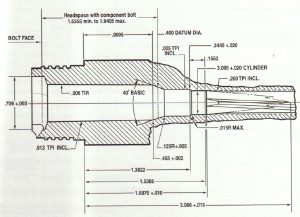 |
 |
 |
Headspace
is one of the most confusing issues presented to the collector of vintage
firearms. It is often misrepresented, and has been bandied about
so much of late that its true impact and import are lost. An understanding
of just what is meant by the term "Headspace" is crucial for the safety
of anyone who habitually fires older or military firearms.
It is our intent to shed a little light on this concept for the new collector.
What
is Headspace?
Headspace
is a term that originated with the earliest self contained metallic cartridges.
These cartridges were invariably rimmed, much like the current .22 Long
Rifle cartridge. When this type of round is placed in a firearm's
chamber, the rim prevents the round from slipping completely into the chamber
by abutting against the rear of the chamber. When the action is closed,
the bolt face comes up against the cartridge head. To the front of
the cartridge's rim is the rear face of the chamber, and to the rear, the
bolt face. Between the rear face of the chamber and the bolt face
must be space enough to fit the rim, or head of the cartridge. This
then, is the definition of headspace for a rimmed cartridge.
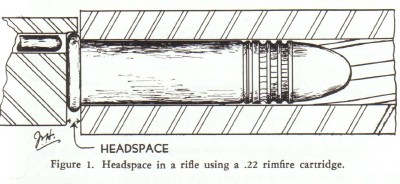
Image Credit: Hatcher, Julian S., Hatcher's Notebook, Stackpole Books (Harrisburg, Pennsylvania, 1966) Page 233 |
In contrast
to the rimmed cartridge, the rimless cartridge has a case head which is
of the same diameter as the case body. As a result, some other means
must be used to limit the forward travel of the cartridge when it enters
the chamber. With straight walled cases, such as a pistol case like
the .45 ACP, the mouth of the case is left squared instead of being crimped
into the bullet. A shoulder is left at the forward edge of the chamber,
and the mouth of the case abuts against this shoulder. Since there
is nothing for the rim to seat against, the traditional meaning of headspace
ceased to have significance, and in order to determine the proper tolerance
for cartridge seating, measurements must be taken from the bolt face to
the shoulder at the front of the chamber. For tradition's sake, this
measurement is also called headspace.
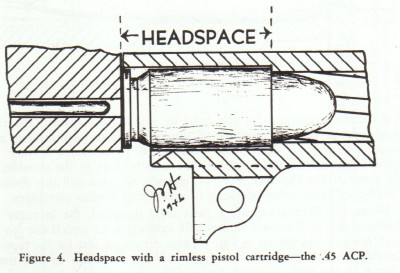
Image Credit: Hatcher, Julian S., Hatcher's Notebook, Stackpole Books (Harrisburg, Pennsylvania, 1966) Page 235 |
Rimless
bottlenecked cartridges, such as the 7.92mm Mauser and the .308 Winchester
do not seat on a lip at the forward edge of the chamber, but rather on
the tapered shoulder which connects to the body of the cartridge to the
neck. Therefore, in rifle cartridges of this type, the distance from the
face of the closed bolt to an arbitrary reference point on the shoulder
in the forward part of the chamber is called headspace.
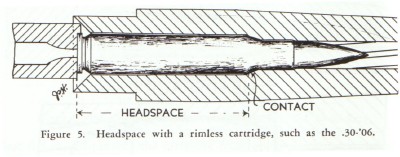
Image Credit: Hatcher, Julian S., Hatcher's Notebook, Stackpole Books (Harrisburg, Pennsylvania, 1966) Page 236 |
Belted
cartridges, such as the .300 H&H Magnum seat on a step in the rear
of the chamber which corresponds to the forward edge of the case's belt.
The distance between the face of the closed bolt and the step in the rear
of the chamber is called headspace, for belted cartridges.
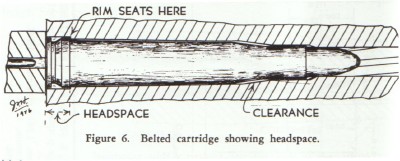
Image Credit: Hatcher, Julian S., Hatcher's Notebook, Stackpole Books (Harrisburg, Pennsylvania, 1966) Page 238 |
What
Effect Can Variations in Headspace Have?
Variations
in headspace measurements, such that a firearm's headspace is either insufficient
or excessive may have the most dramatic effect on firearms chambered for
high power bottlenecked rifle cartridges. When these rounds are touched
off, many, many thousands of pounds of pressure are suddenly forcing the
base of the cartridge to the rear. Exactly the same amount of pressure
is simultaneously exerted in a forward direction, some of it on the bullet,
thrusting it down the bore, and the remainder is pressing forward on the
interior of the case neck and body. The pressure stretches the forward
part of the case tight against the shoulder of the chamber at the same
time the rear of the case is moving backward towards the bolt face.
If there is sufficiently excessive headspace, the case will stretch too
far and rupture. In many instances, a ruptured case will have no
ill effects on the firearm or shooter. In some instances, the effects
can be catastrophic and result in spontaneous disassembly of the firearm
and injury or death to the shooter.
Another
danger posed by excessive headspace is the phenomenon known as "slapback."
Excessive headspace allows the bolt to have a certain amount of play.
Upon firing in this condition, the bolt has room to accelerate rearward
and strike the receiver a sharp hard blow. This sort of direct shock
may overcome the metallurgy in the bolt and receiver and lead to the often
fatal condition known as "bolt in forehead." Another version of slapback
occurs with firearms known to have very hard, and consequently very brittle,
receivers and bolts, such as low numbered M1903 Springfield rifles.
In these instances, the metal has a very strong resistance to a direct
push or pull, but a very low resistance to shock. Such a receiver
may shatter into grenade like fragments under an assault by a bolt that
has had room to accelerate. Additionally, the shock of high speed/high
pressure gas entering the receiver ring or chamber from a ruptured case
may cause the receiver to shatter with similar results.
How
is Headspace Measured?
It is
not possible to conventionally measure headspace in firearms chambered
for rimless bottlenecked cartridges, as the shoulders of the chamber blend
into the slopes and angles in front of and behind them, and there are no
sharp angles from which to measure. As a result, specialized gauges
are used to measure the distance from the bolt face to the datum point
on the chamber shoulder.
These gauges are precision machined instruments, specific to the nominal chambering being measured and standard that they are measuring to, which are of a precise length, usually to within a thousandth of an inch tolerance. It is at best inadvisable to attempt to manufacture one's own headspace gauges unless you are a skilled machinist and gunsmith, and have precision machine tools available. Shimming with sheet steel stock or cellophane tape will not give an accurate reading. Gauges are readily available from supply houses like Brownells, and are not unduly expensive. It cannot be stressed enough that the use of home made or alternative means to measure headspace is playing dice with death.
Commercial headspace gauges usually (though not always) come in sets of three. These three are called the GO, NO-GO and FIELD REJECT gauges, and are of specific lengths to measure minimal chamber length, maximum chamber length in a new rifle, and a chamber length beyond which it becomes unsafe to shoot an "in service" rifle under any conditions respectively. We'll now examine what each gauge indicates in further detail.
The GO Gauge: The bolt must close fully and without resistance on the GO gauge. This signifies that the chamber has met minimal length requirements. If the bolt does not close on the GO gauge, the firearm is not safe to shoot, even if standard ammunition can be successfully chambered. This "force-fitting" of ammunition into the chamber can result in dangerously high pressure situations which in turn can turn the gun's receiver into a grenade - one which you've pressed your face against.
b) The NO-GO Gauge: The bolt on new and overhauled firearms must not close on this gauge. Should the bolt on a new firearm close on this gauge, the gun should be considered defective and returned to the manufacturer. While closure of a new firearm's bolt on the NO-GO gauge does not definitively mean that something is amiss, it is an indication that the firearm is strongly suspect and should be treated with extreme caution.
c) The
FIELD REJECT Gauge: The bolts on ALL firearms must not close on this
gauge. If they do, they should be considered unserviceable.
In many cases, the firearm cannot be repaired and is now suitable only
for decorative or exemplary purposes. In the event that the bolt
has closed on a NO-GO gauge, but not on a FIELD REJECT gauge, it may be
assumed that the firearm is safe to fire with virgin ammunition made to
the same standard as the gun and the gauge. However, this provides
no guarantee of safety. Failure to close on a FIELD REJECT gauge
is merely an indication that a particular danger associated with shooting
is less likely. The only that is certain is that if the bolt
closes on a FIELD REJECT gauge, the gun IS
unsafe.
Headspace
Standards and Measurement Conventions
So now
you know all about headspace. You've purchased a set of gauges from
Brownell's, a box of military surplus
ammunition from some south west Asian country, and once that foreign military
surplus rifle passes muster with respect to the FIELD REJECT, or better
yet, the NO-GO gauge, you're ready to go, right? WRONG.
The information gleaned from the example above is at best useless. At worst, it may allow one to draw the conclusion that the rifle is safe to shoot (as far as headspace is concerned) when it in fact is not. This is due to the fact that there are differing standards and conventions governing matters such as minimum and maximum chamber lengths, maximum cartridge lengths, and headspace gauge dimensions. In order for the data gained by the use of headspace gauges to have any value, three elements must be manufactured to the same standards; specifically, the firearm, the ammunition in question, and the gauges must be made with the same conventions and tolerances. If any one of the three differs, the information gained by the use of the gauges is suspect.
For example, most commercial sporting arms and ammunition made in the United States adheres to a set of specifications standardized by the Sporting Arms and Ammunition Manufacturer's Institute (SAAMI). As a result, commercially available headspace gauges are made to the same standards. Using the SAAMI standard GO, NO-GO, and FIELD REJECT gauges to determine the headspace of a Remington Model 700 BDL rifle chambered for the .308 Winchester is proper. However, making the assumption that the same gauges will give valid readings in a US military rifle chambered for the dimensionally similar 7.62mm NATO cartridge is incorrect and might lead to problems. Why? Because the military and commercial standards for the cartridges, chambers, and therefore, gauges, are significantly different.
For example, the US Rifle, M14, 7.62mm NATO minimum chamber headspace specification is 1.6355." This is .0015" greater than the .308 Winchester commercial NO-GO specification of 1.6340." More importantly, 7.62mm NATO cartridge headspace length averages .002" (or more) longer than the .308 Winchester minimum chamber headspace specification of 1.630."
In another example, the SAAMI specification FIELD REJECT gauge for the .303 British is .070." However, the British military maximum headspace length gauge is .074." In this case if one had a British military rifle with a headspace measurement of .071", and for the sake of argument, British military ammunition, but used SAAMI specification gauges, one might be convinced that a perfectly serviceable rifle had excessive headspace.
A problem is thus defined for the shooter of military surplus firearms. Since these firearms were not manufactured to SAAMI specifications, and the readily available gauges were, and it is anybody's guess as to what standards, if any, the available military surplus ammunition was made to, how can one determine if the headspace on a given rifle means it is safe or unsafe to fire?
The short answer is that one cannot. However, there is a general rule that military tolerances are usually looser than their commercial equivalents. As a result, it is a fair assumption that a military surplus rifle that will not close on a commercial FIELD REJECT gauge will not close on the equivalent military gauge, were it available. However, this is only a general rule. It DOES NOT RENDER THE FIREARM SAFE. This test merely gives some additional data to the shooter in determining if the firearm is more or less safe to fire.
Finally, a word on military surplus ammunition. Governments are not charitable organizations. They do not give away, at bargain prices, ammunition for which they have a use. Military ammunition is surplused because it is old and unreliable, it is unsafe, or, in the best case scenario, because the nation in question has moved on to a new family of weapons using a different cartridge (e.g. from the 7.62mm NATO to the 5.56mm NATO). Consequently, shooters should be wary when using military surplus ammunition.
Summary
Headspace
is a complex and convoluted issue that is fraught with difficulty and inconsistency.
Shooters who fire commercially produced firearms using US manufactured
commercial ammunition can have their firearms readily checked for proper
headspace by a competent gunsmith. For shooters of military surplus
firearms, there are no guarantees, only steps that one can take to minimize
risk. As with all firearms related issues, safety, prudence and caution
are the bywords with which to live.
Note: Data for this month's trivia page was gathered from:
Hatcher, Julian S., Hatcher's Notebook, Stackpole Books (Harrisburg, Pennsylvania, 1966) ISBN 0-8117-0795-4
Kuhnhausen, Jerry, The U.S. .30 Caliber Gas Operated Service Rifles: A Shop Manual, VSP Publishers (McCall, Idaho, 1995)
Hatcher's
Notebook is available from Amazon.com. Click on the image to
order:
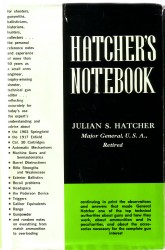
The
U.S. .30 Caliber Gas Operated Service Rifles: A Shop Manual is
available from Heritage Gun Books. Click on the image to order:
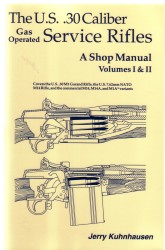
|
|